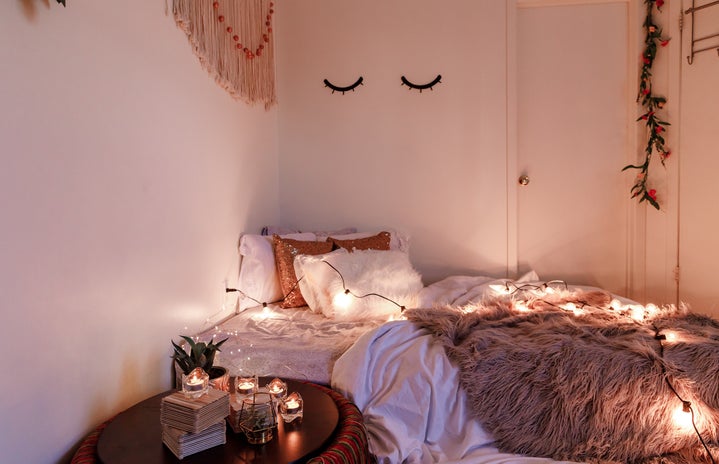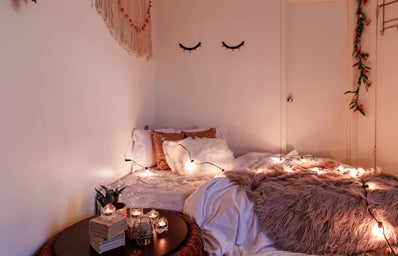If you are a fan of “Gilmore Girls,” you might recall apartment eight, which is the apartment that Rory lived in with Doyle and Paris during some of her time at Yale. This apartment, albeit fictional, was my first glimpse of a college apartment. I noticed how the cozy, mismatched style encapsulated the hygge essence of “Gilmore Girls.”
College is the first time that most students have their own space. If you can relate, you most likely want your living space to reflect who you are as a person, just as Rory’s apartment with Paris and Doyle reflected the “Gilmore Girls” vibe. However, knowing where to start when creating your dream apartment can be overwhelming – and expensive.
To find out the best way to approach designing a rented space on a budget, I spoke with interior designer Cassie Thompson, owner of Thompson Home in South Florida. Cassie’s insight can guide you as you make the big and small design choices on your apartment journey:
1. Start by designing a mood board
You are probably familiar with this process, as TikTok and Instagram are flush with mood board content. Your apartment mood board is a visual representation of the look that you are wanting to achieve. You can either use Pinterest to keep the mood board digital or print and cut out physical photos to glue to a posterboard. No matter what medium you choose to create your board, the important thing is to ensure that it represents your style. Try using keywords like “cozy,” “minimalistic,” “artsy,” “glam” or “boho” to accumulate the inspiration you want. If you are planning on having a roomie, you can create a shared Pinterest board or plan a night where you make a mood board together. Fix some lattes and turn on your favorite playlist and start collaborating! Cassie recommends looking for recurring textures, patterns and colors in your mood board as these design elements can help you find a consistent theme.
2. Look at your future apartment as is before any decor has been added
Notice what you like about the space, and what you would prefer to change. For instance, maybe you love the flooring in your bedroom. Or perhaps you wish that the lime green wall in the living room was a different color. Once you see what you want to enhance or erase, talk to your landlord to see what can be altered. Your landlord might be willing to let you paint or add some backsplash. Cassie even knew of some renters who made small improvements for their landlord, and the landlord decreased their rent as a result. If you are unable to repaint, try looking for renter friendly wallpaper or peel-and-stick tile that can add some (temporary) personal touches to the space. Cassie advises thoroughly reading the reviews of these products to be certain that they are truly renter friendly!
3. Start with the essentials when you first move into the apartment
Investing in essentials can help ensure that you stay within budget because you are prioritizing what items are most important. First, look for a bed that fits your room. You might already have a bed. In this case, try DIY-ing an inexpensive headboard to give it a new look. Some brilliant Pinterest users have created adorable headboards from cardboard and fabric. Second, search for a statement couch, which Cassie describes as a “couch with a lot of character.” Try scouring Facebook Marketplace, Goodwill, or other thrift stores for some pre-loved couches with character. (You can also purchase a couch cover if you aren’t sold on the color.)
Third, purchase some kitchen essentials. “Invest in a good pot and pan if you don’t have the budget for the entire set,” Cassie suggests. Fourth, invest in bathroom necessities, such as towels and washcloths. Cassie advises first-time apartment residents to purchase neutral towels, as these will match any bathroom decor.
4. Once your essentials are in the apartment, wait to see how you use the space before purchasing extra furniture items and décor
This can help you cut down on costs, for it ensures that you are only buying items that enhance the space. Cassie asks, “Do you find yourself using the space in a certain way?” For example, if you find that you and your guests are constantly using the floor space in your living room for game night, you might want to consider a small coffee table that can be easily moved.
Furthermore, you might find that you prefer sitting on the balcony to eat as opposed to a traditional dining table. Therefore, investing in a good quality outdoor set may be a better option than buying a new kitchen table set. Once you have a firm grasp on how you use the space, you can begin to search for pieces that hold meaning and fit your lifestyle.
5. Start looking for detail pieces that represent your personality (Your mood board will definitely come in handy here!)
Cassie advised using some functional items as decor, which can cut down on extra purchases. For instance, Cassie uses a pour over coffee maker as opposed to a coffee pot because it’s both aesthetic and practical. She also recommends using brass hangers and a clothing rack instead of a dresser to display your style in a functional, decorative way. Another fun decor idea is to thrift books that reflect your interests to display on your coffee table and nightstand. Cassie and her family love to travel, so her coffee table holds second-hand books about tourism and interior design. Furthermore, thrifting items like dishes, mugs, paintings and throw blankets can be an inexpensive way to add some character to your space.
In the end, the choices that you encounter on your apartment-designing journey might feel overwhelming, especially when you are on a budget. However, an apartment allowance can be a blessing in disguise because it allows you to prioritize items that truly work for your lifestyle and represent you. Start by creating a mood board that depicts the feel you want your apartment to have. Then, think about how you want to utilize the space that you have been given. After, invest in essentials, such as a bed, a couch, cooking utensils and linens. Once your essentials have been purchased, you can begin to accumulate detail pieces that are both usable and adorable. Cassie gives the following advice: “Take your time. Don’t feel like you have to fill up the space all at once. Think about pieces that have meaning.” Designing your space is a special process; make it unique to you and your values!
About the Interviewee:
Cassie Thompson is the owner of and lead designer at Thompson Home, a Florida-based interior design organization. The construction field introduced Cassie to the world of design, and she fell in love with creating spaces that allow her clients to thrive. In addition to her role as an interior designer, she is a wife and mother that inspires her family by working towards her dream.


